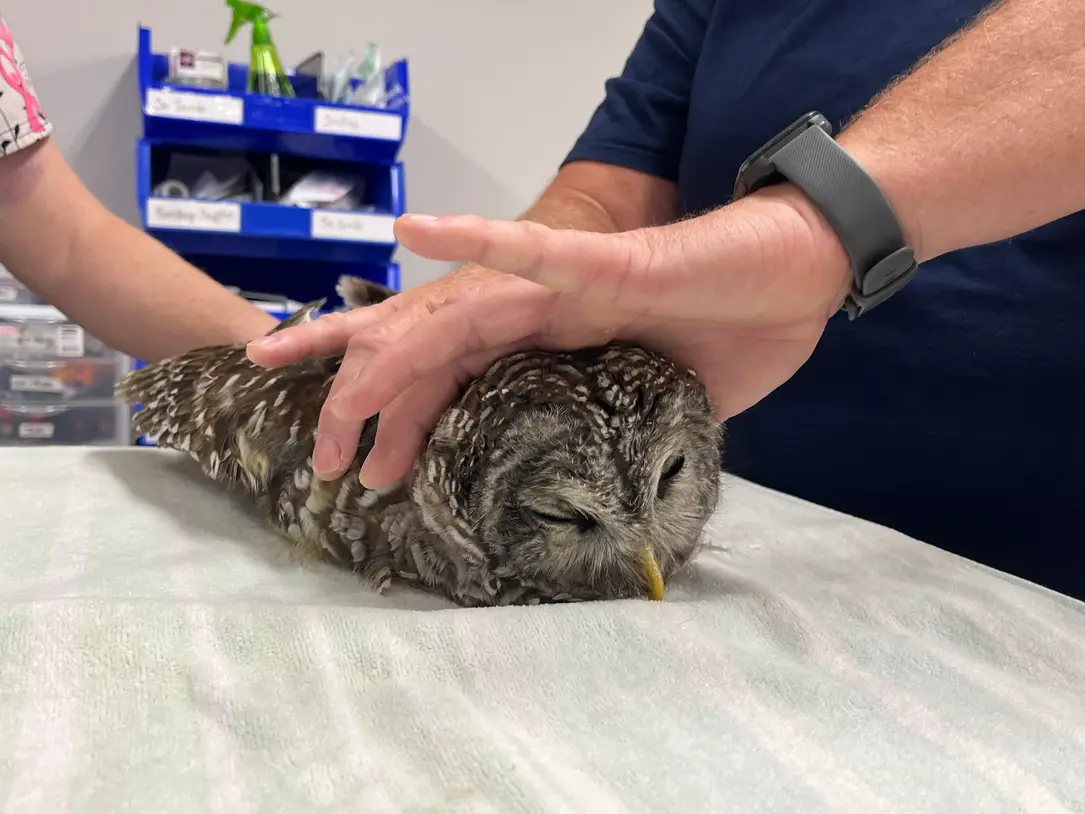Superbowl
For owls that are superb.

US Wild Animal Rescue Database: Animal Help Now
International Wildlife Rescues: RescueShelter.com
Australia Rescue Help: WIRES
Germany-Austria-Switzerland-Italy Wild Bird Rescue: wildvogelhilfe.org
If you find an injured owl:
Note your exact location so the owl can be released back where it came from. Contact a licensed wildlife rehabilitation specialist to get correct advice and immediate assistance.
Minimize stress for the owl. If you can catch it, toss a towel or sweater over it and get it in a cardboard box or pet carrier. It should have room to be comfortable but not so much it can panic and injure itself. If you can’t catch it, keep people and animals away until help can come.
Do not give food or water! If you feed them the wrong thing or give them water improperly, you can accidentally kill them. It can also cause problems if they require anesthesia once help arrives, complicating procedures and costing valuable time.
If it is a baby owl, and it looks safe and uninjured, leave it be. Time on the ground is part of their growing up. They can fly to some extent and climb trees. If animals or people are nearby, put it up on a branch so it’s safe. If it’s injured, follow the above advice.
For more detailed help, see the OwlPages Rescue page.
view the rest of the comments

Yikes! Chiropractic is very much a pseudoscience. The reason people like it is because when the chiropractor cracks your back, it makes your body freak out and release adrenaline, which makes you feel less pain. But as soon as the shock of having had your body yanked wears off, the pain comes back. Plus chiropractors often cause their patients all kinds of spinal injuries.
Which is also not to mention all the other even crazier pseudoscience BS (NET, essential oils, healing touch) that often comes along with it.
Yeah, IIRC the guy who invented chiropractic said that it was taught to him by a ghost
Okay, but in his defense, that ghost was a doctor. A real one. Not a chiropractor.
I thought this was a joke, but it seems not!
From Wikipedia
“The knowledge and philosophy given me by Dr. Jim Atkinson, an intelligent spiritual being ... appealed to my reason,” Palmer wrote in his memoir “The Chiropractor,” which was published in 1914 after his death in Los Angeles. Atkinson had died 50 years prior to Palmer’s epiphany.
From LA Times
Well, them, it's gotta be true!
“Hmm…” pokes owl’s back “I can tell you haven’t been substituting the brown mice for the unhealthier white mice like we discussed last week. And…you’ve clearly been eating processed cougar.”
Could you provide a source on the adrenaline thing?
I'm not who you were asking, but I got curious too. I found this commentary in the NIH database recommending interested parties do further studies into such things, so this is not proof of such things, just describing how it is believed to work, is what I took away, though this one has a lot of big words to me.
The organisation of the stress response, and its relevance to chiropractors: a commentary - 2006
Just wanted to highlight that last bit myself. The author seems to me to be implying there may very well be some scientific basis to the claims, but practitioners are hesitant to follow the scientific method, and the results may also disprove things critical to their existence.
I wasn't sure if I regretted bringing this post to light after the first few comments, but nobody has gotten mean, and we generated some conversation. This is not sign of me moving to more "provocative" posting, fear not, but it has been enlightening to me as your content provider some empirical evidence that controversial or antagonizing content or headlines really does promote engagement, for better or worse. I don't regret doing it, but I want people to be happy coming here, not provoked, but sometimes the need to highlight less pleasant thing is also part of being educated about all things. We dealt with it like adults, so that is enough for a while. We'll be back to fun stuff tomorrow. I still got that Flammy to post, so we can have Flammy Friday. 🔥
Sheesh! Thanks, but I'm not sure if I'm any wiser ;)
It's a pseudoscience for humans, but perhaps it has actual benefits for treating owls.
I feel bad you are being downvoted.
I did a bit more reading as I find it interested so many dislike the chiropractic practice, while an equal number seem to love it.
Animal chiropractic care looks to be its own thing, with its own licensing and requirements separate to what is done to humans. In that it has to be done with supervision from an actual veterinarian, it seems to have somewhat better oversight than when it is done on humans.
It seems the inventor of chiropractic used demonstrations on animals to try to convince people it wasn't made up. The jury is still out on the practice as a whole, and it sounds like many chiropractors also debate whether it is effective on animals. The whole field really seems to be a mess of people from religious whackos and grifters, to some overlap with accepted modern medicine, such as physical therapy, sports therapy, massage, and ice therapy.
If it helps animals is still debated, but there do not seem to be as many studies as have been done on humans. There are cases where injury has resulted, but also large numbers of people who will swear by the practice.
From Wikipedia
So to those downvoting, I get it, and agree with why you are downvoting, but I feel this comment is making a fair point, as we technically don't seem to have as much actual science on veterinary chiropractic results. It may very well be complete bunk, but as it seems hard to nail down an actual definition for what chiropractic care is, if a person is massaging sore animal parts and giving them physical therapy and calling that chiropractics, I don't feel that is necessarily indefensible.
Again, do not take that as a defense of the practice from me, I lean towards the pseudoscience stance, but with all the vagueness of the industry, I don't feel this comment should be dogpiled.
Yeah, I was a bit confused about the downvotes too. It's not like I was saying owl chiropractic care is healthy, I was just suggesting its effects could differ from that on humans. But the internet's just gonna be like that sometimes.
People get confusing sometimes. Most of my posts get at least one downvote, including the one today that explained the medical condition. Whatever makes them happy, I suppose... 🙄